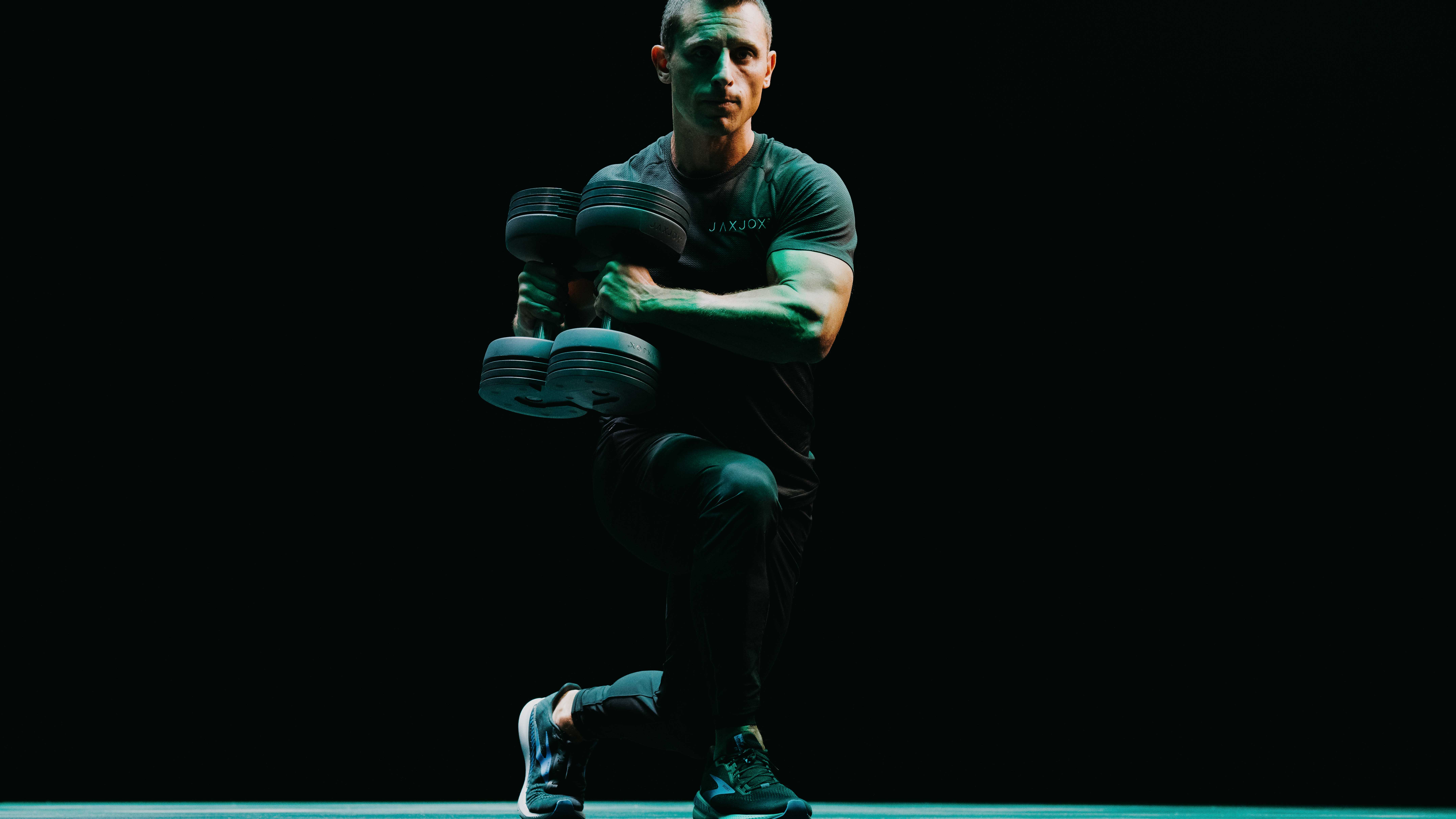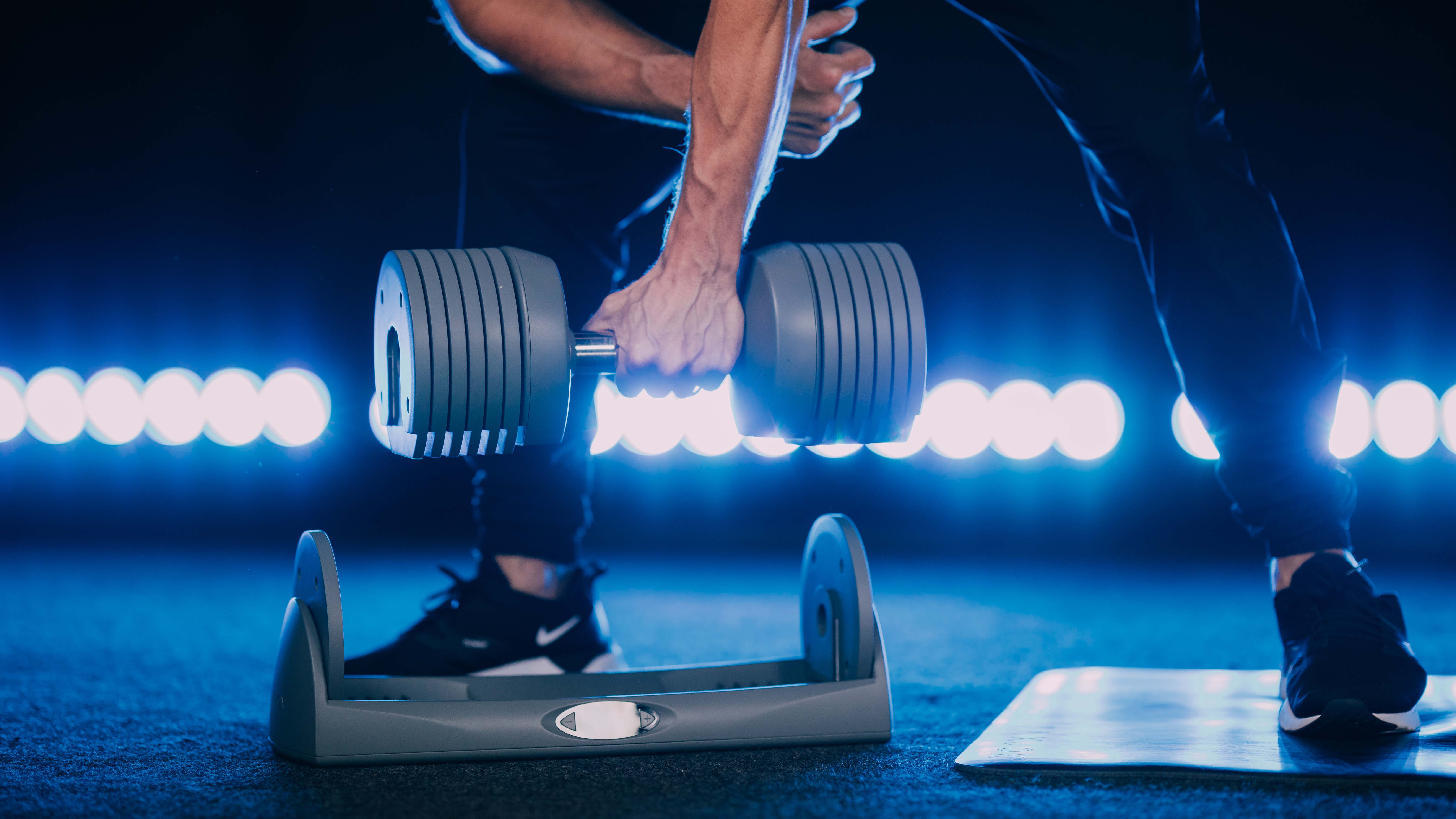

I'm yet to meet a guy who didn't want to get big arms. Or, more like bigger arms. Whatever your arm girth is, it's likely you want to make them even girthier: that's just the way the brain works. And if you're one of these people, you'd better listen to what dumbbell expert Lionel Balland has to say.
"Home fitness changed during the pandemic because people were forced to work out at home. When you couldn’t leave your house to go to the gym, you had to figure out how to bring the gym to you.", says JAXJOX Coach and dumbbell expert Lionel Balland, "What people learned during this experience is that it’s very viable to work out from home. You can get a good quality workout, and there are lots of resources to show you how to do it from home."
When it comes to home workouts, using dumbbells is one of the most effective and convenient ways to build muscles, boost metabolism and tone up. That's because you can train all the major muscle groups of your body using a wide variety of exercises without massive home gym equipment taking up all valuable floor space in your home.
Better still, the best dumbbells are not only convenient but also super-efficient. These amazing home weights involve numerous stabilizing muscles to assist the movements when dumbbell exercises are performed. More muscles moved equals faster gains and more calories burned, after all. Here are the best tricep exercises with dumbbells to get you started.
Not to mention, dumbbells are also very durable and will last a lifetime. This is especially true to cast iron and rubber hex dumbbells but also adjustable dumbbells. All things considered, a set of dumbbells should be your very first fitness equipment purchase when building a home gym.
(On the market for new home gym equipment? Check out T3's mathematical guides on the best kettlebells, best barbells and best weight benches.)
How much weight do you need for dumbbells?
If you haven't ever used a dumbbell, it can be challenging to know what weight is right for you. The puny little 2-3 lbs (~1kg) dumbbells look rather small, but it might be worth giving them a try if you haven't done dumbbell home workouts before.
Get all the latest news, reviews, deals and buying guides on gorgeous tech, home and active products from the T3 experts
"When working out with dumbbells, it is important to pick the appropriate weight for each exercise", says Lionel, "You can buy a set that has a wide range of dumbbell weights so that you can start light and work up as you improve. Alternatively, you can buy adjustable dumbbells like the JAXJOX Dumbbell Connect, which can give you a full set of dumbbells using the space of just one pair."
Another benefit of adjustable dumbbells is that they allow for a more varied workout without buying loads of dumbbells. Especially at the beginning, it's hard to gauge how much you can curl or bench press, so the weight range an adjustable dumbbell has can come in real handy.
As for how many times you should lift dumbbells in each set, let Lionel explain what rep-range you should use:
"If you are trying to tone your muscles and build up your endurance, you should pick appropriate weights that will tire you out above 12 repetitions."
"If your goal is to gain muscular size, you want to pick weights that will tire you out by a rep count of 8 to 12 repetitions."
"If increasing your strength is your goal, you should focus on lifting heavier weights that will tire you out before 8 repetitions."
Whatever is your goal, try spicing up your workouts with different rep ranges to have a more well-rounded physique.

How to perfect your dumbbell form to increase workout efficiency
Contrary to popular belief, heavy weights alone won't give you the results you're after; good form is equally important. Jerking the weights and half-repping your sets will result in minimal muscle activation, so it's important to focus on form first and only use weights heavy enough with which you can perform exercises correctly.
"Performing exercises in front of a mirror may help you ensure that your form is appropriate for dumbbell routines", suggests Lionel, "Ideally, start by doing slower repetitions so that you force your muscles to really control the weight, as opposed to rushing through an exercise using momentum. By starting with slower movements and lighter weights, you will build your joints and muscles so that they’ll be able to move up to heavier weights when you’re ready safely."
Getting some help from a pro might help, too: "Receiving guidance from a fitness professional and/or watching instructional videos will teach you the proper form for various exercises", Lionel adds.

How to correctly warm up before a dumbbell workout
Warm-ups are like leg days: people like to skip them as often as possible. A shame, really, as doing the proper warmup can actually help you lift bigger. It can also prevent injury so that you can lift more often for quicker gains.
"A warm-up involves doing exercises at a lower intensity and slower pace, which improves your athletic performance, prevents injuries and helps with recovery from exercise", Lionel explains, "Warming up before exercise prepares your cardiovascular system for physical activity by increasing the blood flow to your muscles and raising your body's temperature. It also helps to lower the risk of getting injured — when your muscles are adequately warmed up, the movements, stretches, and strain you put on them during your workout are less severe. This also minimizes muscle soreness."
Warm-up can be anything from jogging on a treadmill to having a 5-10-minute session on a stationary bike. Ensure the warm-up is not too intense or long, as it can tire out the muscles before you begin your strength workout.

Why it's important to stretch after your dumbbell workouts
"A lack of flexibility can cause movement to become slower and less fluid, making an individual more susceptible to muscle strains or other soft tissue injuries. This can put a damper on active lifestyles. An increase in flexibility is accompanied by improved balance and coordination", Lionel says.
He goes on: "It's best to stretch after your workout when your muscles are warm, not before the workout. If you stretch a cold muscle, you could potentially pull it. Even doing just a few static stretches at the end of a workout will help with muscle soreness the next day and keep you moving freely."
As for how hard you should stretch, Lione suggests stretching to about 60 to 70% of your pain tolerance: do not overstretch! "Ease into your stretches and hold them for about 30 seconds", he says, "It is good to focus on stretching the muscles you train during the workout, but doing full body stretches at the end of your workout can also be very beneficial."

Matt Kollat is a journalist and content creator who works for T3.com and its magazine counterpart as an Active Editor. His areas of expertise include wearables, drones, fitness equipment, nutrition and outdoor gear. He joined T3 in 2019. His byline appears in several publications, including Techradar and Fit&Well, and more. Matt also collaborated with other content creators (e.g. Garage Gym Reviews) and judged many awards, such as the European Specialist Sports Nutrition Alliance's ESSNawards. When he isn't working out, running or cycling, you'll find him roaming the countryside and trying out new podcasting and content creation equipment.